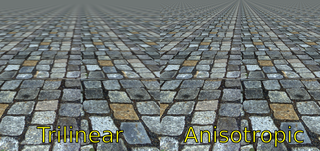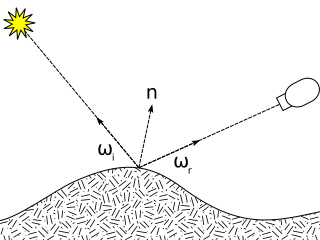Related Research Articles

Rendering or image synthesis is the process of generating a photorealistic or non-photorealistic image from a 2D or 3D model by means of a computer program. The resulting image is referred to as the render. Multiple models can be defined in a scene file containing objects in a strictly defined language or data structure. The scene file contains geometry, viewpoint, textures, lighting, and shading information describing the virtual scene. The data contained in the scene file is then passed to a rendering program to be processed and output to a digital image or raster graphics image file. The term "rendering" is analogous to the concept of an artist's impression of a scene. The term "rendering" is also used to describe the process of calculating effects in a video editing program to produce the final video output.

In 3D computer graphics, anisotropic filtering is a method of enhancing the image quality of textures on surfaces of computer graphics that are at oblique viewing angles with respect to the camera where the projection of the texture appears to be non-orthogonal.

The Catmull–Clark algorithm is a technique used in 3D computer graphics to create curved surfaces by using subdivision surface modeling. It was devised by Edwin Catmull and Jim Clark in 1978 as a generalization of bi-cubic uniform B-spline surfaces to arbitrary topology.

Non-photorealistic rendering (NPR) is an area of computer graphics that focuses on enabling a wide variety of expressive styles for digital art, in contrast to traditional computer graphics, which focuses on photorealism. NPR is inspired by other artistic modes such as painting, drawing, technical illustration, and animated cartoons. NPR has appeared in movies and video games in the form of cel-shaded animation as well as in scientific visualization, architectural illustration and experimental animation.

Kenneth H. Perlin is a professor in the Department of Computer Science at New York University, founding director of the Media Research Lab at NYU, director of the Future Reality Lab at NYU, and the Director of the Games for Learning Institute. He holds a BA. degree in Theoretical Mathematics from Harvard University (7/1979), a MS degree in Computer Science from the Courant Institute of Mathematical Sciences, New York University (6/1984), and a PhD degree in Computer Science from the same institution (2/1986). His research interests include graphics, animation, multimedia, and science education. He developed or was involved with the development of techniques such as Perlin noise, real-time interactive character animation, and computer-user interfaces. He is best known for the development of Perlin noise and Simplex noise, both of which are algorithms for realistic-looking Gradient noise.

The bidirectional reflectance distribution function (BRDF), symbol , is a function of four real variables that defines how light from a source is reflected off an opaque surface. It is employed in the optics of real-world light, in computer graphics algorithms, and in computer vision algorithms. The function takes an incoming light direction, , and outgoing direction, , and returns the ratio of reflected radiance exiting along to the irradiance incident on the surface from direction . Each direction is itself parameterized by azimuth angle and zenith angle , therefore the BRDF as a whole is a function of 4 variables. The BRDF has units sr−1, with steradians (sr) being a unit of solid angle.

Marching cubes is a computer graphics algorithm, published in the 1987 SIGGRAPH proceedings by Lorensen and Cline, for extracting a polygonal mesh of an isosurface from a three-dimensional discrete scalar field. The applications of this algorithm are mainly concerned with medical visualizations such as CT and MRI scan data images, and special effects or 3-D modelling with what is usually called metaballs or other metasurfaces. The marching cubes algorithm is meant to be used for 3-D; the 2-D version of this algorithm is called the marching squares algorithm.
Software visualization or software visualisation refers to the visualization of information of and related to software systems—either the architecture of its source code or metrics of their runtime behavior—and their development process by means of static, interactive or animated 2-D or 3-D visual representations of their structure, execution, behavior, and evolution.
Thomas Albert "Tom" DeFanti is an American computer graphics researcher and pioneer. His work has ranged from early computer animation, to scientific visualization, virtual reality, and grid computing. He is a distinguished professor of Computer Science at the University of Illinois at Chicago, and a research scientist at the California Institute for Telecommunications and Information Technology (Calit2).

Patrick M. Hanrahan is an American computer graphics researcher, the Canon USA Professor of Computer Science and Electrical Engineering in the Computer Graphics Laboratory at Stanford University. His research focuses on rendering algorithms, graphics processing units, as well as scientific illustration and visualization. He has received numerous awards, including the 2019 Turing Award.

Computer graphics is a sub-field of computer science which studies methods for digitally synthesizing and manipulating visual content. Although the term often refers to the study of three-dimensional computer graphics, it also encompasses two-dimensional graphics and image processing.

Andrew Paul Witkin was an American computer scientist who made major contributions in computer vision and computer graphics.
Jarke J. (Jack) van Wijk is a Dutch computer scientist, a professor in the Department of Mathematics and Computer Science at the Eindhoven University of Technology, and an expert in information visualization.
Maureen C. Stone is an American computer scientist, specializing in color modeling.

Jean-Daniel Fekete is a French computer scientist.

Bedrich Benes is a computer scientist and a researcher in computer graphics.
IEEE Transactions on Visualization and Computer Graphics is a peer-reviewed scientific journal published by the IEEE Computer Society. It covers subjects related to computer graphics and visualization techniques, systems, software, hardware, and user interface issues. TVCG has been considered the top journal in the field of visualization.
Thomas K. Porter is the senior vice president of production strategy at Pixar and one of the studio's founding employees.
Julie Dorsey is an American computer scientist specializing in computer graphics. With architecture as a driving application, her research in computer graphics has included work on high-dynamic-range imaging, image-based modeling and rendering, and billboarding. She is the Frederick W. Beinecke Professor of Computer Science at Yale University, and the founder and Chief Scientist of 3D sketching software company Mental Canvas.
Wolfgang Heidrich is a German-Canadian computer scientist and Professor at the King Abdullah University of Science and Technology (KAUST), for which he served as the director of Visual Computing Center from 2014 to 2021. He was previously a professor at the University of British Columbia (UBC), where he was a Dolby Research Chair (2008-2013). His research has combined methods from computer graphics, optics, machine vision, imaging, inverse methods, and perception to develop new Computational Imaging and Display technologies. His more recent interest focuses on hardware-software co-design of the next generation of imaging systems, with applications such as high dynamic range (HDR) imaging, compact computational cameras, hyper-spectral cameras, wavefront sensors, to name just a few.
References
- ↑ "Holly Rushmeier appointed the Malone Professor of Computer Science". 4 March 2019.
- ↑ "Rushmeier lauded for work in computer graphics". 14 August 2013.
- ↑ "Holly Rushmeier, Cornell University, Ithaca, NY Major: Mechanical Engineering BS 1977, MS 1986, PHD 1988. Joined Yale Faculty 2004. | Computer Science".
- ↑ "Holly Rushmeier". May 2024.
- ↑ "Press Backgrounder: Art Historian & IBM Scientists Embark on Most Extensive Study Ever Done on a Single Work of Art". July 1998.
- ↑ "ACM TOG | Editors". tog.acm.org. Archived from the original on 22 May 2015. Retrieved 17 January 2022.
- ↑ Cacm Staff (March 2017), "ACM Recognizes New Fellows", Communications of the ACM , 60 (3): 23, doi:10.1145/3039921, S2CID 31701275
- ↑ "Fellows – Eurographics".
- ↑ "Awards". 24 February 2022.
- ↑ "Eurographics Gold Medal".
- ↑ "Digitally rebuilding a lost city". /news.yale.edu. 13 December 2022. Archived from the original on Mar 30, 2023.